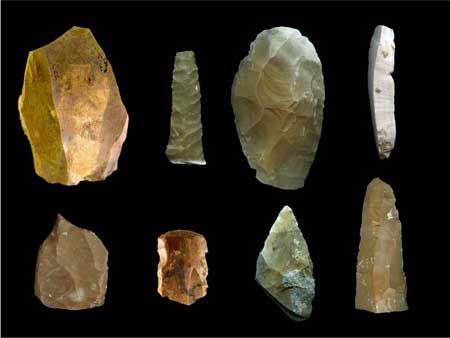“We are beginning to understand that the first peoples in the New World were just like us: intelligent, inventive, creative — and they found ways to adapt to a rapidly changing world.” – Dr. D. Clark Wernecke, director of the Gault School of Archaeological Research

PHOTO: westerndigs.org
AUSTIN, TEXAS – Archaeologists have found what may be the some of the oldest tools found in the American West so far. The tools date back over 16,700 years, much older than the artifacts they had previously thought to be the oldest known stone tools in the area. The site is home to 90 tools, some human teeth, and over 160,000 stone flakes – debris from the tool manufacturing, a process called knapping.
Up until now, the archaeologists believed a prehistoric Paleo-Indian culture, named Clovis (after the site where their distinct stone tools were originally found in Clovis, New Mexico), to be the oldest distinct culture on the North American continent. It was from Clovis that most of the Native American cultures were believed to have had their root.
![Clovis Point tools, found in Iowa. [PHOTO: wikimedia]](https://historythings.com/wp-content/uploads/2016/07/300px-Clovis_Rummells_Maske.jpg)
Clovis Point tools, found in Iowa. [PHOTO: wikimedia]
The oldest known Clovis site is believed to be El Fin del Mundo, in Sonora Mexico. It was discovered in 2007, and it’s believed to be almost 14,000 years old.
Archaeologists were working on a site known as the Gault site in Texas when they discovered the older tools. In the early parts of the dig, they found tapered-oval spear heads that they believed to be a clear indication that the Clovis culture flourished at the site. This first find was made in the 1990s.
In 2002, Dr. D. Clark Wernecke and his associates began a new dig at the site. They came for Clovis. What they found was something much more significant.
They spent years digging test pits all around the site, but they came up empty-handed.
“In Area 12, you have the pavement, lithics and bone, and not much else.” – Dr. Clark Wernecke
So, they moved on to a new part of the site: Area 15. At first they found what they were looking for: Clovis-style tools. When they dug deeper, however, they found something new, including human teeth.
![Area 15. [PHOTO: westerndigs.org]](https://historythings.com/wp-content/uploads/2016/07/gault-site-excavation.jpg)
Area 15. [PHOTO: westerndigs.org]
Even though the tools were found beneath Clovis tools and they were clearly not Clovis tools, that didn’t mean they were older. To make sure, the researchers sent them off for lab dating.
The results were staggering.
The tools are as old as 16,700 years – 3,000 years older than the earliest Clovis artifacts in North America.
If the Clovis didn’t make them, then who did? That question, so far, remains a mystery.
Initially, the best theory we had as to how humans arrived in North America was a theory developed in 1590 by Jose de Acosta, a Spanish missionary. He said that the people probably walked here across a land bridge between Alaska and Russia. That theory held water as long as the Clovis were the oldest known culture, but now they’re not.
15,000 years ago that land bridge was blocked by glaciers during the Ice Age. These would have been impossible to cross. The earliest peoples in North America, then, must have traveled to North America by boat.
Wernecke and his colleagues will continue to excavate the site in Texas in an attempt to learn more about this pre-Clovis culture. Their find has colossal implications for the archaeological community in North America. Some textbooks will have to be rewritten!
“The most important takeaway is that people were in the New World much earlier than we used to believe. We were all taught [humans first arrived in North America] 13,500 years ago, and it appears that people arrived 15,000 to 20,000 years ago.” – Dr. D. Clark Wernecke

